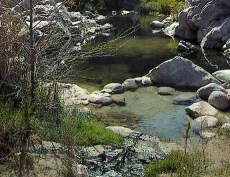Management challenges related to urbanization include:
* increasing numbers of people coming to the forests for a growing number of activities. There are increased demands for a variety of high quality year-round recreation opportunities, especially day-use activities including picnicking, driving, and trail use, as well as access to dispersed areas where people recreate.
* retaining the opportunity for solitude in the face of the increasing population. As development of private areas continues, we anticipate a greater dependence on the forests for this type of value. Solitude defines itself and is becoming an increasingly rare opportunity in many areas of the national forests.
* accommodating the demand for an increasing variety of forest products due to the diversity of the surrounding populations and the demand for products used for weaving, floral displays, medicinal, or other uses. Managers are also challenged to effectively communicate with diverse populations of people in order to understand the ways they would like to use the forests.
* access to national forest land. Access is a complex problem that has many forms. For example, traditional points of access to the forests are lost as land is developed. New landowners are often reluctant to accommodate access across their land. At the same time, the people living adjacent to the forests want convenient access, often resulting in the development of unplanned roads and trails. Roads are another form of the access challenge. Most of the forests road system was constructed in the 1930s for fire protection and are narrow and steep with few, if any, turnouts or other safety features. Maintenance backlogs, road reconstruction or relocation, access for modern fire fighting equipment and the decommissioning of roads are just a few of the challenges facing our transportation planners.
* infrastructure for community support. There are numerous facilities already located on the forests including utility corridors, communication sites, electronic sites, dams, diversions, and highways. The role of the forests and how they are used to accommodate additional facilities while retaining the character of the landscapes is a significant challenge.
* accommodating the demand for a wide variety of water uses with a limited supply of water in one of the driest climates in the United States. The demand for water for community, commercial, or private use has resulted in numerous impoundments, diversions and wells. Finding the delicate balance between peoples' need for water and the water necessary to sustain healthy riparian and wetlands in the forests will continue to be a challenge. Healthy, stable, and resilient watersheds absorb rain, refill aquifers, cool and cleanse water, slow storm runoff, reduce flooding, and provide important habitat for fish and wildlife. Water users include people, who are particularly attracted to water because of hot temperatures and the arid climate, downstream cities and communities that use the water for municipal water supplies, as well as the numerous plants and animal species that depend on water for their survival. The demand for water can only increase as the population increases. Water is a complex challenge as the existing above ground sources may be fully used and subsurface (groundwater) supplies are at least heavily tapped for municipal or private water or for commercial uses (water bottling). Maintaining the quality of water is a challenge because of the intense levels of human use, air pollution, or natural events such as landslides, flooding and post-fire erosion. Managers are challenged to improve impaired watersheds by 20% over the next five years.
* understanding and protecting the historic and cultural sites that are abundant in the four southern California forests. Numerous tribes live adjacent to or near the forests. Managers are challenged to develop government-to-government relationships with the tribes in order to protect resources, to resolve access issues, supply resources and to continue the important traditional or cultural uses of the forests.
* law enforcement. Forest staff will continue to be challenged by growing urban populations and a vast number of illegal or inappropriate activities.
Forest Service Plan on Urbanization Challenges
All posts are those of the individual authors and the owner
of this site does not endorse them. Content should be considered opinion
and not fact until verified independently.
| Subject | Author | Views | Posted |
|---|---|---|---|
| katrina island | 888 | May 14, 2004 01:38PM | |
| katrina island | 497 | May 14, 2004 01:57PM | |
| katrina island | 489 | May 14, 2004 01:59PM | |
| katrina island | 892 | May 14, 2004 02:01PM |
Sorry, only registered users may post in this forum.




